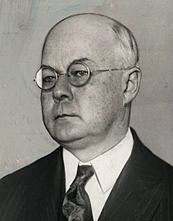
Frank Navin
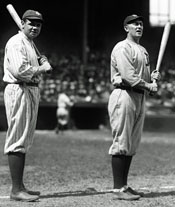
Babe Ruth and Ty Cobb
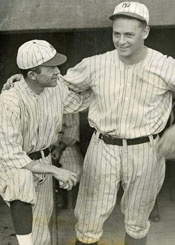
Miller Huggins and Waite Hoyt

Ed Barrow

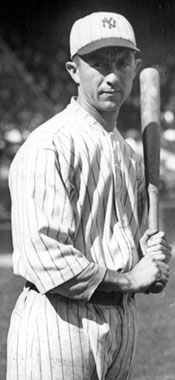
Frank Baker
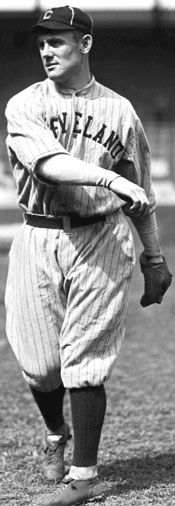
Ray Chapman

Carl Mays

John McGraw
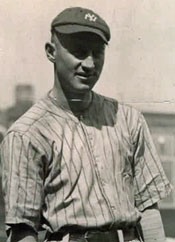
Tom Sheehan
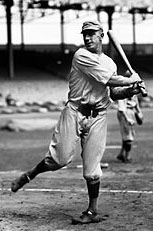
Braggo Roth
|
June 12, 1921 - Ty vs Babe
The Detroit Tigers of first-year player-manager Ty Cobb got off to a surprising start in 1921.
- The Tigers had won three pennants in a row from 1907-09 but lost the World Series every year.
- However, the 1910-19 decade had not been kind to the club. Two second-place finishes and two thirds were the best the club could produce for owner Frank Navin.
- When the Tigers slid to 7th in 1920, 37 games off the pace set by the Cleveland Indians, Navin jettisoned 14-year manager Huey Jennings in favor of Cobb, who, at age 34, could still produce at the plate and in the field. The Detroit owner was influenced by the fact that another OF, Tris Speaker, had led the Indians to the 1920 World Series championship. Navin raised Ty's salary from $20,000 to $35,000 to persuade him to take a job he did not want.
- The "Tygers," as many sportswriters dubbed them, had stayed in the first division of the American League through early June and brought a 29-25 to the Polo Grounds June 11 for a four-game series with the Yankees.
- As was typical in those seasons, the Tigers were on an extended road trip that would take them to each of the four Eastern cities of the league: Philadelphia, Washington, New York, and Boston. Throw in a series at Cleveland after the Eastern swing, and Detroit would spend the period from June 1-June 21 away from home.
- So far, the Tigers had kept their heads above water in hostile environments, boasting a 5-4 mark on the trip heading into the Big Apple.
The Yankees were in the second-year of a new era that began with the famous trade that brought Babe Ruth to the nation's largest city (5.6 million, almost 3 million more than second-place Chicago).
- The addition of Ruth had produced 15 more victories than the 80 the 1919 club achieved. Miller Huggins' club had finished 3rd, only three games behind the Indians.
- Babe himself had put together what many baseball historians still consider one of the greatest seasons any player has ever enjoyed. He led the AL in runs (58), HRs (an astounding 54, 25 more than his record-setting number with the Red Sox in 1919, his first campaign as a full-time outfielder), RBI (135), walks (150), and slugging % (.847) as well as some statistics that have been retroactively calculated: On-Base % (.532) and On-Base + Slugging % (1.379).
- Ruth had dazzled the entire nation to the point that, by 1921, newspapers across the country were printing a daily log of his at-bats.
The biggest addition to the club for 1921 was GM Ed Barrow, another acquisition from Boston.
- Barrow immediately set about remedying the weaknesses that had kept the 1920 Yanks from winning their first pennant.
- In still another trade with Boston, he acquired veteran C Wally Schang and RHP Waite Hoyt.
- Frank "Home Run" Baker returned to 3B. He had retired in 1920 after losing his wife to scarlet fever.
- Another player returning to the club was OF Elmer Miller, who had spent the 1919 and 1920 seasons at St. Paul in the American Association. He joined Bob Meusel alongside Ruth in the outfield.
All in all, the Yankees seemed poised to make a strong run at the franchise's first AL crown.
- They entered the series with the Tigers at 29-21, good for 2nd place, 2.5 games behind Cleveland.
- Ruth had continued his fabulous hitting from the beginning of the season. He stood at .352 with 17 HRs and 47 RBIs.
Baseball was transitioning in 1921 from what could be termed "Cobb Ball" to "Ruth Ball."
- "Cobb Ball" was the equivalent of today's "small ball." The emphasis was on getting a runner on 1B and either bunting him over or having him steal 2B. Then drive him home with a single or double. Batters "hit the ball where it's pitched," trying to line the ball over or between the infielders.
- "Ruth Ball" meant more slugging. Take a full swing even with two strikes. The increased number of strikeouts would be overcome by far more extra base hits.
Several factors converged in 1920 to help Ruth Ball gain the advantage.
- Baseball partially banned the spitball (and "shine balls" and other pitches that relied on doctoring the baseball in some way) for the 1920 season. Each team could designate at most two pitchers who would be permitted to legally throw spitballs. Then, for 1921, the spitball was banned except for a list of 17 pitchers who were allowed to keep throwing the pitch until they retired.
- A tragic event also aided hitters. On August 17, 1920, Cleveland SS Ray Chapman died after being hit in the head by a pitch thrown by the Yankees' Carl Mays. As a result of the incident, the rules makers ordered umpires to keep fresh, white baseballs in play at all times.
- But perhaps the most important change was an improved method of manufacturing baseballs that took effect in 1920. Companies began to use machine winders and a higher grade of yarn from Australia. The new, "livelier" balls seemed to go further than those from what was now termed the "Dead Ball Era" (pre-1920).
- Here's the relevant statistics from the 1919, 1920, and 1921 major league seasons that show the marked improvement in offense.
| |
Bat. Avg. |
Runs/Game/Team |
HRs |
| Season |
NL |
AL |
NL |
AL |
NL |
AL |
| 1919 |
.258 |
.268 |
3.6 |
4.1 |
207 |
240 |
| 1920 |
.270 |
.283 |
4.0 |
4.8 |
261 |
369 |
| 1921 |
.289 |
.292 |
4.6 |
5.1 |
460 |
477 |
Cobb passionately defended the Deadball Era-style of play.
- He mocked the "swing crazy" batters of the "modern" (post-1920) game. He claimed the Deadball game demanded intelligence as well as physical skill.
- Ty considered baseball a "game of hit-and-run, the steal and double steal, the bunt in all its wonderful varieties, the squeeze, the ball hit to the opposite field, and the ball punched through openings in the defense for a single."
- Baseball purists focused their wrath on Ruth, whom Ty did not consider an allaround good ballplayer. The Detroit skipper hated Babe because he did not need to study and scheme but just walked to the plate and tried to hit the ball as hard as he could. In short, he didn't practice "scientific baseball." An article in The Sporting News, already "baseball's bible," agreed with Cobb.
As a batter, Ruth is an accident. He never plays inside baseball at the plate. He goes up trying to take a swing on every strike, a style that would cause any other player to be benched. He either knocks home runs or strikes out. Any man who strikes out as many times as Ruth did last year [1921] can never be classified as a great hitter.
- The fact that Ruth mania swept the nation and that attendance skyrocketed throughout both leagues infuriated Cobb all the more. According to ballparksofbaseball.com, total attendance for the 16 ML teams rose 39.6% from 6,532,479 in 1919 to 9,120,875 in 1920.
- The Yankees led all of baseball in home attendance in 1920 with 1,289,422. That particularly irritated Giants manager John McGraw, who shared the Polo Grounds with the Yankees. McGraw and Cobb did not get along, but they were of one mind in favoring pre-1920 baseball and hating Babe Ruth.
The Giants would try to oust the Yankees after the 1920 season but settled for raising the rent. Determined not to be caught in a bind like that again, Barrow began plans to build his own stadium, which would be completed in time for Opening Day 1923.
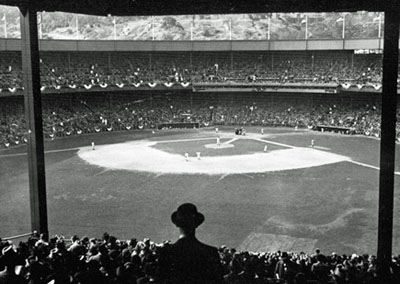
Polo Grounds in 1921 Amid this backdrop, let's return to the 1921 season.
- The Yankees had visited the Motor City May 10-13 and won three of four, drawing as many as 20,000 for the opener on a Tuesday afternoon.
- Ruth's two-run HR in the first inning provided all the runs that Mays needed for the 2-1 victory.
- The Tigers reversed that outcome the next day despite a single and a double by Babe. Rookie righthander Suds Sutherland outdueled Hoyt. Ruth was thrown out twice on the bases, once trying to stretch a single into a double and again on a daring steal of home. H. G. Salsinger wrote in The Detroit News, While to many people Ruth is faster than they think he is, Ruth is not quite as fast as Ruth thinks he is.
- The Bambino clouted another round tripper the next day as the visitors plated two in the 9th to pull out an 11-10 victory in a game that featured 30 hits.
- Ruth's bases loaded triple sparked the 6-4 Yank win in the finale as Mays got his second save, as it would be called today, in as many days. Detroit hurler Howard Emhke pitched carefully to Babe, walking him three times.
Now jump ahead to June 11 and the opener of the four-game series between the Tigers and Yankees in New York.
- 28,000 saw the Tigers jumped on Hoyt for three in the first, but the Yankees pecked away at Jim Middleton, scoring one in each of the first three frames to tie.
- The visitors regained a 3-run margin in the top of the 7th only to see New York tie the fray again in the bottom half of the inning on a three-run blast by, who else?, Babe Ruth. Cobb had refused to allow his pitchers to walk Babe intentionally or even pitch around him.
Sporting News columnist John B. Sheridan wrote that he had never seen a baseball issue generate more heat than the intentional walking of Ruth. Fans came to the ballpark to see the slugger hit, not walk. But how could you blame teams for doing what they could to win the game? Ruth set a record by walking 148 times in 1920. During one series in St. Louis, a local paper ran the headline, "Pay a Dollar at Sportsman's Park to See Babe Ruth Walk."
But Cobb had steadfastly bucked the trend. His pitchers generally challenged Babe. Why? Perhaps it was Ty's competitive nature. Or he didn't want to cheat the fans of what they came to see. Or maybe he stubbornly refused to publicly acknowledge
Babe's greatness.
- That set the stage for the bottom of the 9th when P Tom Sheehan, RF Braggo Roth, and SS Roger Peckinpaugh, the last with Ruth on deck, smacked consecutive singles to send home the winning run.
- Cobb went 3-for-3 with a double.
Sunday baseball in New York City had been legalized prior to the start of the 1919 season, with an immediate positive impact on attendance for the Giants, Yankees, and Brooklyn Dodgers.
- Now a whole new class of fans, those who worked six days a week, could attend games.
- The New York Tribune put it this way in a May 5, 1919 article the day after the first Sunday game in the Polo Grounds: Up to yesterday, baseball in greater New York was for the semi-idle ... Yesterday those bleachers teemed with life. The men from the docks and the factories came and they brought their wives and children. Those dark green benches held thousands of fans who never in their lives had seen a big league game.
With the lure of Cobb as well as Ruth, 34,000, 6,000 more than Saturday, filled the seats for the second game of the series at 3 PM Sunday, June 12, 1921.
|
Starting Lineups
Detroit Tigers
| Ralph Young |
2B |
.259 |
| Donie Bush |
SS |
.300 |
| Ty Cobb |
CF |
.401 |
| Bobby Veach |
LF |
.347 |
| Harry Heilmann |
RF |
.429 |
| Bob Jones |
3B |
.370 |
| Lu Blue |
1B |
.338 |
| Johnny Bassler |
C |
.302 |
| Suds Sutherland |
P |
6-2 |
|
 |
 |
New York Yankees
| Braggo Roth |
RF |
.278 |
| Roger Peckinpaugh |
SS |
.293 |
| Babe Ruth |
CF |
.354 |
| Wally Pipp |
1B |
.296 |
| Bob Meusel |
LF |
.287 |
| Home Run Baker |
3B |
.292 |
| Aaron Ward |
2B |
.301 |
| Wally Schang |
C |
.237 |
| Bob Shawkey |
P |
3-2 |
|
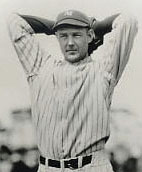
Bob Shawkey
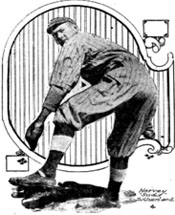
"Suds" Sutherland

Wally Pipp
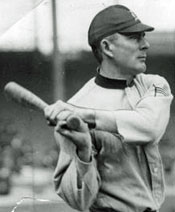
Bobby Veach

Bill Dinneen

Roger Peckinpaugh

Lu Blue
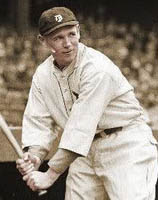
Harry Heilmann
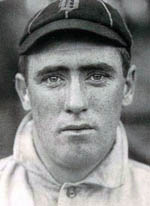
Donie Bush
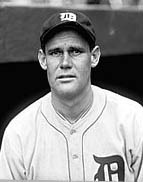
Dutch Leonard
|
The ill will started before the game.
- During batting practice, Ruth refused to have his picture taken with Cobb. Babe added a few innuendos about Ty, who responded by pretending to be a gorilla, pushing his nose up. Ruth charged Cobb but the umpires kept them apart.
- Ty explained in his biography: Whenever I'd pass near him on the field, I'd make some little remark or gesture, such as, "Do any of you fellows smell something? Seems to me there's a polecat around here."
- The chief Tyger also carried on a running verbal battle with P Carl Mays in the Yankee dugout. The two had never gotten along since Mays hit Cobb with a pitch the first time he faced him, causing Ty to throw his bat at him.
- Those encounters set the tone for a chippy game that Harry Bullion of The Detroit Free Press summarized like this: Close to 32,000 people were undecided whether to weep out of shame for the athletes, give vent to joy or feel insulted at the spectacle.
Right-hander Bob Shawkey, who had missed starts earlier in the season with a shoulder problem, started for the Yankees.
- Shawkey had won the final game of the Cleveland series two days earlier when he pitched the 9th, 10th, and 11th.
- When the Tigers' scoreless half-inning ended, Cobb and Ruth exchanged words as they crossed paths in CF.
A side-arming righty, rookie Harvey "Suds" Sutherland, toed the slab for the Tigers.
- He retired the first two batters before facing Ruth.
- The Babe walked on a 3-2 pitch but was left stranded.
An Oregonian, Sutherland had won his first five games, beguiling the hitters with his slow stuff. He also showed himself an excellent hitter, compiling a .385 average. Cobb even used him as a pinch-hitter. But on May 15, a fastball from Walter Johnson plunked Suds on his pitching arm. He was never the same after that.
After a scoreless second, Detroit broke the ice in the third.
After the visitors failed to add to their lead, Babe led off the Yankee 4th.
- He clouted the 2-2 pitch foul over the RF stands. Then he swung viciously and fanned. Cobb whistled and roared out in CF.
- The Yanks scored a run to cut the lead in half.
- As the teams changed sides, Ruth and Cobb squared off as if to fight. They stared at each other until umpire Bill Dinneen and several players pulled them apart.
The roof fell in on Suds in the 5th.
- Peckinpaugh came up with the sacks full and cleaned them off with a triple to put NY ahead 4-2.
Considered the best defensive SS in the AL, Peckinpaugh served as captain of the Yankees.
The Senators would acquire Roger for the 1922 season, and he would lead them to back-to-back pennants in 1924-25. He managed the Indians from 1928-33.
- Cobb finally agreed to walk Babe. But the fourth pitch wasn't wide enough, and Babe clubbed the ball into the upper deck for his 19th HR of the season and third in three days. He was now five days ahead of his record 1920 HR pace.
- After the HR, Cobb ran in from CF and first argued the ball was foul. When that didn't work, he started berating Sutherland, who had surrendered four straight hits. Then, perhaps to punish him, the skipper left Suds in for another four hits - punishment?
- When the smoke cleared, the Yankees had seven runs and an 8-2 lead.
But the Tigers, following the spirit of their manager, didn't give up.
Ruth came up with the bases empty and one out in the bottom of the 6th.
- He swung and missed a 1-1 changeup. After running the count full, he doubled to CF.
- However, he was out trying to steal third.
The only news from the 7th was that Ty and Babe smiled as they passed on their way to/from CF.
The 8th was not as peaceful.
- The Tigers hung another 3 spot on the board to pull into a tie.
- When Huggins removed Shawkey after a triple by Heilmann, Bob yelled at his manager so loud that fans all over the stadium could hear. Jack Quinn finished the inning but not without more turmoil.
Hitting .429 heading into the game, Heilmann led the American League in hits (237) and batting average (.394) in 1921. He would hit over .390 three more times, including .403 in 1923. His .342 career average earned him election to the Hall of Fame in 1952.
- After Heilmann scored the tying run, Blue collided at the plate with Schang, after which the two began to fight. Both teams poured out of their dugouts. Cobb helped break up the Blue-Schang tiff. Then Ty and Babe found each other and were about to square off when Huggins tackled his star to keep him out of trouble. Detroit backup C Eddie Ainsmith rushed to the plate to challenge somebody and Yankee OF "Ping" Bodie responded. The melee didn't end until Blue arranged a fight with Yankees coach Charley O'Leary under the stands after the game. (No word on whether the pugilists made good on their pledges.)
- When the inning ended, Ty patted Babe on the back as they exchanged positions.
The tie didn't last long.
- Dutch Leonard, on the downslope of his career that started with six sterling years (90 wins, 64 losses) with Boston, took over the mound duties.
- But the first batter he faced, Peckinpaugh, poled a four-bagger.
- Then Ruth doubled to RF on a 1-1 pitch.
- Pipp singled to CF to send Babe home.
- Eventually two more runs scored to make it 12-8.
Quinn mowed through the Tigers in the 9th.
- When 2B Aaron Ward tossed out Cobb, it was the first putout by Pipp on a grounder.
- 3B Bob Jones made the last out on another 4-3 play.
- The 2:50 time for the contest was enormous for its day but understandable in light of the numerous interruptions.
Six future Hall of Famers appeared on the rosters of the two teams in that wild Sunday game at the Polo Grounds.
- Tigers: Ty Cobb, Harry Heilmann
- Yankees: Frank Baker, manager Miller Huggins, Babe Ruth
Waite Hoyt watched the game from the dugout.
The 12,000 who showed up on Monday for Game 3 of the series got a big surprise.
- Taking the mound to start the game was none other than George Herman Ruth.
- Batting in his usual #3 position, Babe continued his onslaught on Tiger pitching with two more HRs.
- Ruth moved to CF after the fifth inning, having pitched long enough to be the pitcher of record in the 13-7 victory.
The Yankees swept the Tigers out of town the next day with a 9-6 win.
- Babe swatted two more roundtrippers to end the series with these numbers:
9-for-12, .750, 9 R, 12 RBI, 2 2Bs, 6 HRs
- Cobb could manage only this:
7-for-18, .389, 4 R, 3 RBI, 2 2Bs, 1 HR
The Yankees did indeed win the 1921 pennant by 4.5 games over Cleveland. The Tigers sank to sixth, 27 games in arrears.
John McGraw got the satisfaction of
upending his tenants five games to three in the last best-of-nine World Series ever played.
|
|
References: 1921: The Yankees, the Giants, & the Battle for Baseball Supremacy in New York,
Lyle Spatz and Steve Steinberg (2010)
"Exit the King," Charles Leerhsen, Sports Illlustrated, May 11, 2015
|
|
|























